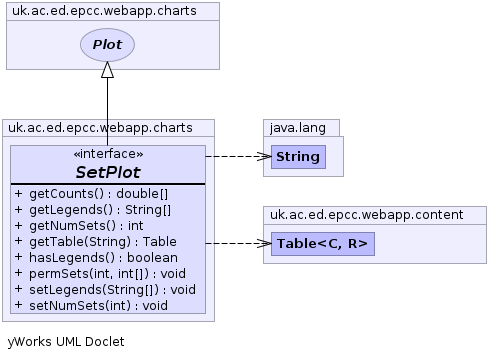-
- All Superinterfaces:
- Plot
- All Known Subinterfaces:
- PeriodPlot, PeriodSequencePlot, PeriodSetPlot, SingleValueSetPlot
- All Known Implementing Classes:
- AbstractPeriodSetPlot, AbstractSingleValueSetPlot, GenericSetPlot, GenericSplitSetPlot, JFreeSetPlot, SplitSetPlot, TimeChartDataSet
public interface SetPlot extends Plot
Plot represents the Data in the chart being created. The data is grouped into sets with each set being displayed separately.
-
-
Method Summary
All Methods Instance Methods Abstract Methods Modifier and Type Method and Description double[]getCounts()sum the contents of the dataset returning an array by setjava.lang.String[]getLegends()get the legend stringsintgetNumSets()get the number of sets.TablegetTable(java.lang.String quantity)Create a table representing the data in thisSetPlot.booleanhasLegends()voidpermSets(int new_nset, int[] perm)permute the contents of the sets in a Dataset labels are also permuted/truncated.voidsetLegends(java.lang.String[] leg)set the legends strings These are the labels for the different sets in thisSetPlotvoidsetNumSets(int nsets)set Number of sets in thisSetPlot
-
-
-
Method Detail
-
setNumSets
void setNumSets(int nsets)
set Number of sets in thisSetPlot- Parameters:
nsets-
-
getCounts
double[] getCounts()
sum the contents of the dataset returning an array by set- Returns:
- double[]
-
getNumSets
int getNumSets()
get the number of sets.- Returns:
-
permSets
void permSets(int new_nset, int[] perm)permute the contents of the sets in a Dataset labels are also permuted/truncated.- Parameters:
new_nset- number of sets to truncate toperm- permutation array, can be many to one to merge sets
-
hasLegends
boolean hasLegends()
-
getLegends
java.lang.String[] getLegends()
get the legend strings- Returns:
- String[] legends
-
setLegends
void setLegends(java.lang.String[] leg)
set the legends strings These are the labels for the different sets in thisSetPlot- Parameters:
leg-
-
getTable
Table getTable(java.lang.String quantity)
Create a table representing the data in thisSetPlot. Each set of data produces a row of the table keyed by the corresponding label. The data columns produced are chosen by the implementing class subject to the advice that multipleSetPlots that can co-exist in a single chart should also make sense when combined into a single table.- Parameters:
quantity- Quantity name if known- Returns:
- Table
-
-
